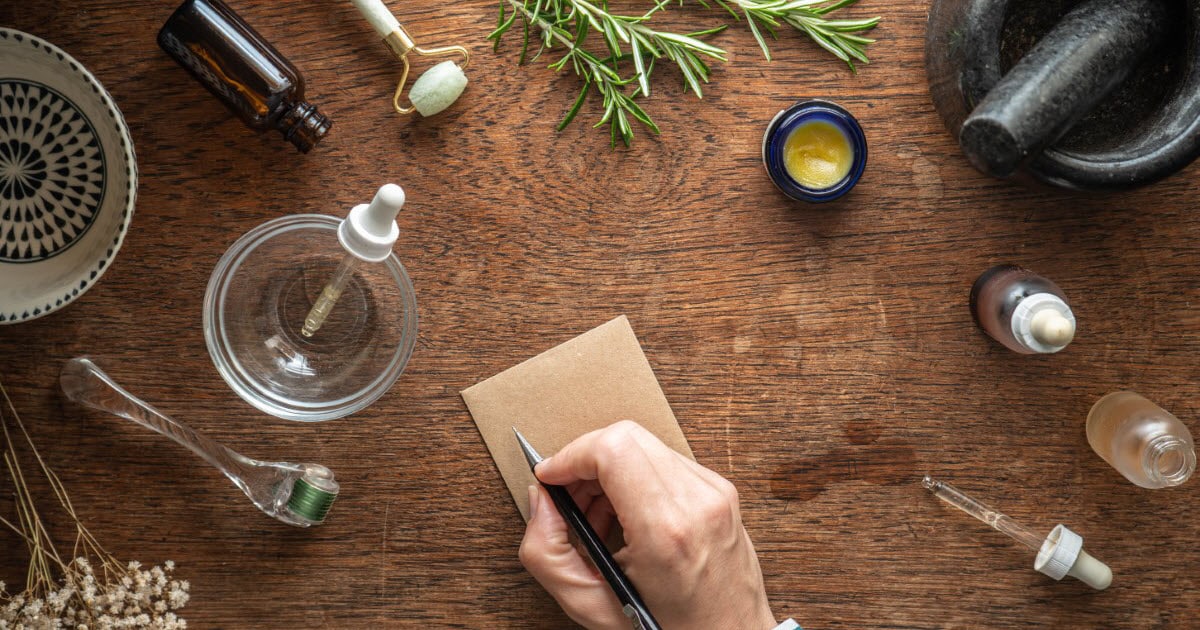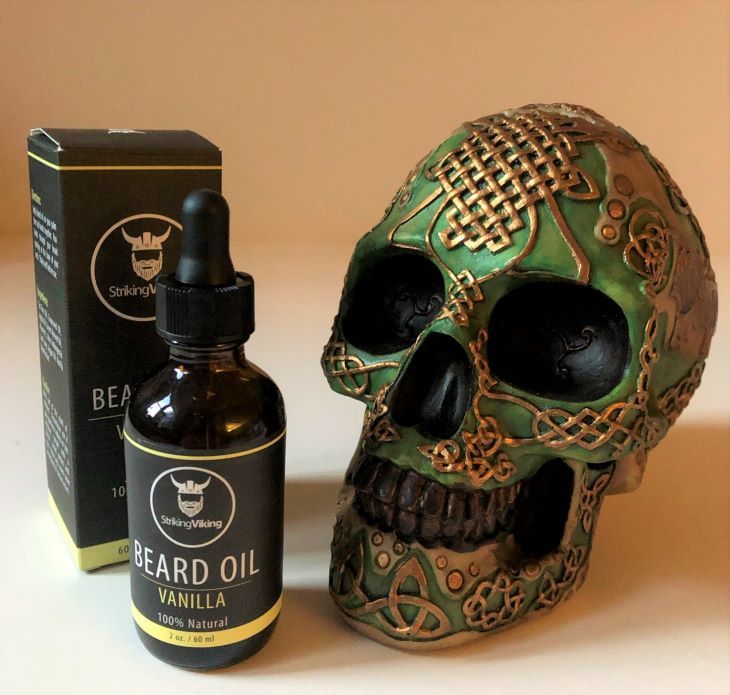Beard oils are kind of funny: in one sense, they’re really easy to make (our instructions below basically boil down to “mix, and then shake, and then you’re good to go”), but in another sense, they’re surprisingly easy to mess up, because you can add too much of this, or too little of that, and then the balance is all off and you’ve got a weird, stinky mess you don’t want to wear. It’s one of those “looks-easy-but-actually-difficult” DIY projects. Luckily, we’ve done all the experimenting for you, and today we’ll share how to make
- Going to the beach? We got something fun and tropical.
- Got a big date? We have something serious but enticing.
- Want to just lie around and smell masculine? We’ve got you covered.
The best part about all of these homemade beard oils is that once you get the hang of it, you’ll be able to mix and match and create a fragrance that’s uniquely yours.

So let’s dive in. In today’s article we’ll go over what’s in a
So What’s in a Beard Oil , Anyway?
Beard oil is basically just a mixture of various oils that condition and moisturize the hair of your beard as well as the skin underneath it. It’s usually a carrier oil (for moisturization) and an essential oil (for scent). It can make your beard feel more comfortable and look fuller and healthier, and in many cases, it can help maximize growth.
What You’ll Need to Make a Beard Oil
This sounds like a lot, but you’ve probably got most of this lying around the house:
Tools You’ll Need
A Jar: You’ll need some kind of container to mix the oil in before funneling it into a small bottle for application. Mason jars work great.
Bottles: Ideally, you should get amber glass bottles since this will preserve the oil by protecting it from UV light. You can choose the size based on how much oil you plan to make, but most people go with a simple 1-oz bottle. If you get a large bottle, you could potentially skip the mason jars.
For added convenience, make it a dropper bottle. This will help you easily mix the oil as well as apply it when you’re ready to use it.
Dropper: Droppers are long glass or plastic tubes with a plastic or rubber squeezer on top that lets you suck oil into the device and squeeze it out wherever you want to apply it.
You don’t need a dropper, but they help.
Measuring spoons: To accurately make a recipe, you’ll need to have some way to measure the oils you’re mixing. Many droppers include measurement lines, but if yours doesn’t, you’ll need measuring spoons.
Scale: In recipes, large quantities of oil are often measured in ounces. Since this is a unit of weight, you’ll need a scale if you want to measure it exactly right. However, you can bypass this with rough weight-to-volume equivalents. For instance, an ounce of oil is roughly two tablespoons. Alternatively, you can find ounce measuring cups, like those used in bartending.
Funnel: If you decide to make a large amount of oil in a jar and then move small amounts into a bottle, you may need a funnel. This will make transferring the oil easier than with the dropper.
Glass stirrer: You’ll need a stirrer to mix the oils together once you’ve combined them. It’s best to avoid metal like spoons as these could potentially react with the oils. A glass stirrer is best, or you may be able to find a wooden one.
Carrier Oils
Earlier, we mentioned carrier oils. They’re the “workman” of a
These are our favorite carrier oils, along with their benefits:
Jojoba: Jojoba, also known as “goat nut” and “wild hazel,” is a plant native to the American Southwest. It’s arguably the best carrier oil for beards and very popular among DIY oil enthusiasts. It’s good for all skin types and has moisturizing and anti-aging properties. It’s non-allergenic as well.
Argan: Argan oil comes from the seeds of a tree native to Morocco. It’s used for culinary purposes as well as cosmetic oils. It’s good for all skin types, has anti-aging and moisturizing properties, and is non-comedogenic, meaning it won’t clog pores, and non-allergenic.
Avocado: Everyone loves avocado on their toast (or so the retirees tell us), but the oil extracted from the delicious fruit is also great for cosmetics. It’s good for many different skin types and very moisturizing. It has a low comedogenic rating (meaning, it’s less likely to give you acne).
Hemp: Hemp oil is extracted from the cannabis plant and has become increasingly popular in recent years for a variety of uses. It’s great for all skin types, has moisturizing and anti-aging properties, and is non-comedogenic and non-allergenic.
Castor: Castor oil is made from castor beans and has many industrial uses in addition to its use in skincare products. It’s good for all skin types, has moisturizing and anti-aging properties, and is minimally comedogenic.
Almond: Almond oil is great for both cooking and skincare. It’s good for all skin types, and it has anti-aging and moisturizing properties. It has a low comedogenic rating.
Coconut: Coconut oil has a unique chemistry among plant-based oils due to its large ratio of saturated to unsaturated fat. As for skincare, it’s very moisturizing and great for the skin.
Apricot: Apricot oil is made from the kernels of the fruit. It’s moisturizing and has anti-aging properties.
Olive: Humans have been using olive oil for millennia. It’s not just great for cooking, though. Its moisturizing and anti-aging properties make it useful as a carrier oil for skincare products like
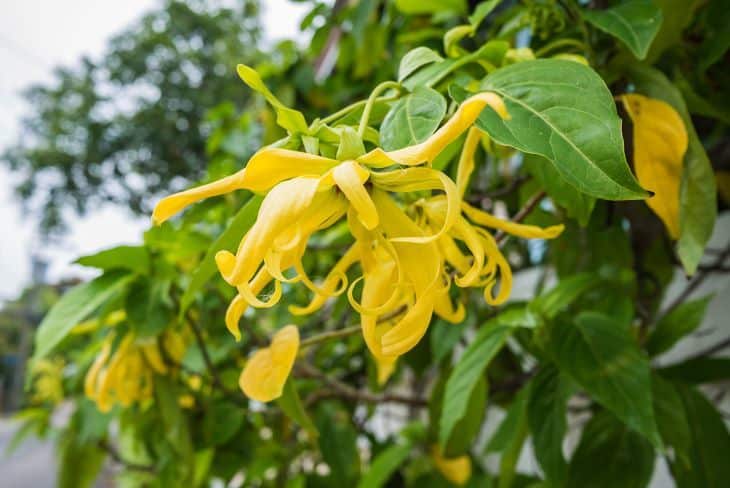
Ylang Ylang has a very sweet scent
Essential Oils
You have, no doubt, heard a lot about these over the last few years. They’re not medicinal, and they have no healing power over disease, but they DO smell really nice and they can provide some benefits for skin and hair.
Think of essential oils as the active ingredients in your
Here are some of the best essential oils for beards and what they do:
Cedarwood: can help prevent acne and has a woodsy, masculine scent.
Citrus/orange: an antioxidant and antiseptic, can relieve inflammation.
Cinnamon: repels insects and is anti-fungal as well.
Peppermint: has anti-inflammatory properties and can refresh tired skin.
Eucalyptus: calming, can reduce irritation from shaving.
Clove: has anti-inflammatory and potentially even anti-cancer properties.
Amla: helps repair damaged hair.
Tea tree: relieves irritation and can reduce redness and swelling.
Bay laurel: anti-bacterial, some believe it can stimulate hair growth.
Lavender: can calm sun damage, and the scent helps with sleep and mood.
Ylang ylang: has a very sweet, very gentle scent.
Myrrh: has a perfume-y, cologne-like scent, and can relieve skin irritation.
There are many more—and in fact, there are over 100 essential oils, all with unique benefits. You can mix and match them to create the best
Of course, you don’t have to include any essential oils at all. If you aren’t looking to give your beard a good scent, or if you’re sensitive to strong smells, you can just stick with the carrier oils.
Our Top Six Favorite DIY Beard Recipes
The first is pretty simple, and it’s one of our favorites:
Recipe 1: Fresh Forest Beard Oil
Ingredients:
1½ ounce jojoba oil
½ ounce argan oil
½ ounce almond oil
20 drops cedarwood oil
10 drops amla oil
5 drops tea tree oil
Instructions:
Add the oils to a jar and mix with a glass stirrer. Using a funnel, transfer a small amount to a dropper bottle for application.
Benefits:
The Fresh Forest recipe provides a woodsy scent great for those going for the “lumberjack” look. The essential oil combo is also great for those long lumberjack beards since it can help repair damaged hair and relieve irritation caused by a scratchy beard.
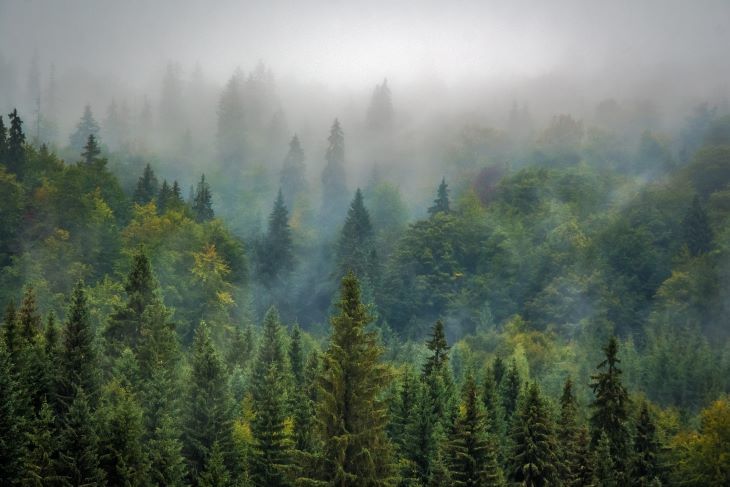
Recipe 2: Ruggedly Rugged Beard Oil
Ingredients:
1½ ounces castor oil
½ ounces hemp oil
½ ounces argan oil
20 drops eucalyptus oil
5 drops cedarwood oil
5 drops tea tree oil
5 drops bay laurel oil
Instructions:
Add the oils to a jar and mix with a glass stirrer. Using a funnel, transfer a small amount to a dropper bottle for application.
Benefits:
This
Recipe 3: Beachy Boy Beard Oil
Ingredients:
1 ounce hemp oil
½ ounce avocado oil
½ ounce jojoba oil
¼ ounce coconut oil
¼ ounce apricot oil
20 drops lavender oil
7 drops orange oil
7 drops lemon oil
Instructions:
Add the oils to a jar and mix with a glass stirrer. Using a funnel, transfer a small amount to a dropper bottle for application.
Benefits:
Ole Beachy Boy is a great

Recipe 4: Seasons’ Greetings Beard Oil
Ingredients:
1 ounce argan oil
½ ounce almond oil
½ ounce apricot oil
½ ounce coconut oil
10 drops cedarwood oil
10 drops cinnamon oil
10 drops peppermint oil
5 drops orange oil
Instructions:
Add the oils to a jar and mix with a glass stirrer. Using a funnel, transfer a small amount to a dropper bottle for application.
Benefits:
As the name suggests, this recipe is great for the holidays and meshes well with classic wintery scents. The highly moisturizing carrier oils and anti-inflammatory, revitalizing essential oils can also help protect your skin during the colder months.
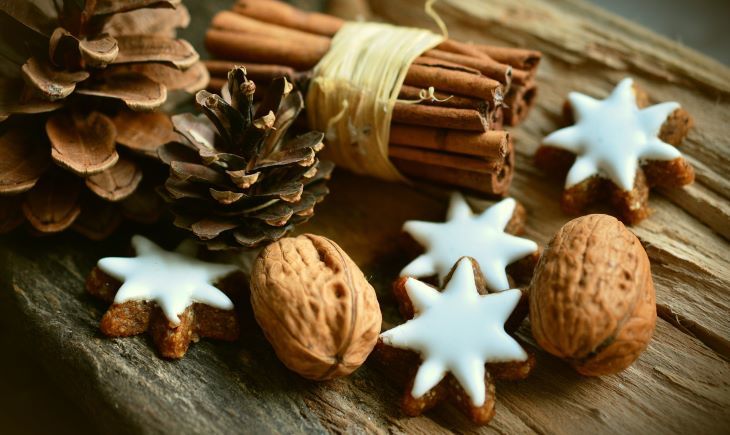
Recipe 5: Big Date Beard Oil
Ingredients:
1 ounce jojoba oil
½ ounce castor oil
½ ounce argan oil
½ ounce almond oil
15 drops ylang ylang oil
10 drops rosewood oil
5 drops myrrh oil
5 drops orange oil
Instructions:
Add the oils to a jar and mix with a glass stirrer. Using a funnel, transfer a small amount to a dropper bottle for application.
Benefits:
This

These two are on a very serious date
Recipe 6: Mediterranean Flare Beard Oil
Ingredients:
1½ ounce castor oil
1 ounce almond oil
1 ounce olive oil
10 drops bay laurel oil
10 drops rosewood oil
10 drops clove oil
5 drops orange oil
Instructions:
Add the oils to a jar and mix with a glass stirrer. Using a funnel, transfer a small amount to a dropper bottle for application.
Benefits:
Mediterranean people are known for their long life expectancies and relaxed, healthy lifestyles. This scent fits that feeling, and is both lively and relaxed, and a great “lounge-around” scent.
How to Create Interesting Scents on Your Own
One of the most fun parts of DIY
As you can see from our recipes, though, you can easily create themes by matching similarly scented essential oils. For instance, peppermint and cinnamon are typical culinary spices that complement each other quite well, and they’re best known for Christmas, so—wallah! You’ve got a holiday
That said, there are a couple things you should keep in mind. First, especially sweet oils like orange can be really strong. It’s best to use them in smaller amounts against a base of a more neutral scent like rosewood. Additionally, when making your own
Benefits of Making Your Own Beard Oil
We’ve been doing this for a while, and wish more people were on board. Here’s why it can be such a great idea to create your own beard oils:
They Can Soften and Repair Your Beard Hair
Anyone who’s grown out their beard can tell you that the hair has a tendency to get rough and scratchy. This is especially true at the beginning before the tips of the hairs wear down. Those who work outdoors or live in cold or dry environments may also find that their beard can get pretty uncomfortable.
Beard oils help soften the hair to prevent the feelings of roughness. They lubricate the strands of hair and allow them to more easily mesh together instead of scratching against the skin. Oils also trap water in the hair, which keeps the hair from drying out.
Similarly,
By softening and repairing your beard hair, you can also treat beard itch. When your beard gets rough and dry, it can irritate the skin, which is what results in the itch. It can even lead to a rash. Making your own
They Moisturize and Treat Your Facial Skin
Unfortunately, having a beard can cause a lot of complications for the skin underneath it. It increases oil build-up, provides a dark and moist place for fungus or bacteria to grow, and can irritate it through fiction.
Beard oil can help treat these problems. First and foremost, it can moisturize the skin. The oils provide a layer that traps in water and keeps the skin from drying out. This prevents flakiness and beard dandruff.
Furthermore, using essential oils, you can treat certain skin problems beneath your beard. For example, certain essential oils are antiseptic or antifungal and can help relieve these infections. Others can prevent inflammation and decrease acne.
By making your own
They Can Smell GREAT
Considering it’s attached to their faces, it’s amazing how often men don’t realize the foul odor of their own beards. Beards build up sweat, oil and dirt that can all contribute to the smell.
Beard oils can help clean your beard and prevent the build-up of sweat and grime. Of course, by using essential oils, you can also perfume your beard and give it a positive, attractive scent instead of a bad one.
Beard oils are especially great because the smells are unique, natural and stronger thanks to the lack of processing.
They Can Nourish Your Beard to Maximize Growth
Commercial
Beard length and thickness is ultimately controlled by genetics, but if your body, skin and hair don’t have the nutrients, vitamins and minerals they need, your beard will be shorter and weaker than it otherwise could be.
Beard oil can help vitamins and minerals, especially essential fatty acids, reach your hair follicles to maximize growth. More importantly, it keeps the hair hydrated which helps with growth and keeps hairs from falling out or breaking prematurely.
You Can Pick and Choose Your Oils
Making your own
Specifically, here are some things to look out for:
Non-Comedogenic Rating
The comedogenic rating refers to whether a specific oil can clog your skin’s pores. Oils get a score from 0-5 with 5 being the most likely to clog your pores.
In fact, oils rated 4 and 5 are almost certain to clog your pores. This leads to acne like red zits, whiteheads and blackheads. Oils rated 0-1 shouldn’t clog your pores, even if you’re prone to acne, while those rated 2-3 are generally okay but may cause acne in those with oily or acne-prone skin.
If you suffer from acne and oily skin, stick to non-comedogenic oils. Here are the ratings of the oils on our list:
Jojoba: 2
Argan: 1
Avocado: 3
Hemp: 0
Castor: 0
Almond: 2
Coconut: 4
Apricot: 2
Olive: 3
As you can see, coconut oil is highly comedogenic. We recommend you only use it if you have dry skin and rarely get acne. Still, you should only apply it to the beard hair and avoid putting it directly on the skin.
On the flipside, if you do suffer from acne, hemp and castor oil can be great choices, as well as argan oil.
Allergies
People can have a wide range of allergies to nearly anything. You certainly don’t want a
Plus, mass produced oils may be manufactured in facilities that also handle whatever product you’re allergic to. This makes it a lot safer to make your own oil at home if you have an allergy to any kind of oil.
While someone could potentially have an allergic reaction to any oil or product, a few are common allergens that people should watch out for:
Avocado oil: Those with an avocado allergy should avoid avocado oil. Interestingly, people with a latex allergy are more likely to develop an avocado allergy.
Argan oil: Argan oil is made from the nut of the argan tree, so those with an allergy to tree nuts should avoid it.
Almond oil: Almonds tend to be the least allergenic of the tree nuts, and sometimes those with allergies to other nuts can still consume almonds. Nevertheless, we recommend that those with a tree nut allergy avoid almond oil in their
Although these are some of the more common allergies that you could encounter while making
Avoid Preservatives
One of the biggest DIY
When you make your own
Save Money
Of course, as with a lot of DIY projects, making your own
The best way to cut costs is to buy your ingredients in bulk if you can. Often you can get packages of essential oils, purchasing a certain number of oils for a discount. This way you can make several different beard oils and use a different oil each day. You can also get carrier oils in large quantities.
The main problem is that you may not need quite so much oil, and you don’t want it to go bad before you can use it. One solution? Get a buddy or two who also use
Another solution is to use the oil for other things. Your wife or significant other may want to use the oil to make lotions or other skincare products. Plus, some of the carrier oils can even be used for cooking.
Have Fun and Learn Something
Last but not least, DIY projects are always fun. If you recruit a friend or significant other as we mentioned before, it can even be a social event.
In the long term, learning how to mix essential oils and take advantage of their unique properties is a great skill to have as well. Not only will you get better at making
How to Use and Store Your Homemade Beard Oil
We’ve actually gotten a few questions about this, so here you go:
Use Separate Jars and Bottles
Your most convenient option is to store your homemade
A good option is to mix your
Keep Your Beard Oil Away from Heat and Light
As you’ve probably seen written on most cosmetic products, you should store your
It’s best to use amber bottles for application. The tinted glass will prevent UV light from reaching the oil. Still, try to keep your bottles of
Shake the Bottle Before Application
Before you use the
Apply After You Shower
The best time to put on
Make sure to pat your beard dry first, but don’t overdry it or irritate the skin by rubbing the towel aggressively over your beard. You still want the hair to be a little moist. This way the
Apply a Little at a Time
You don’t want to overdo it when it comes to
For this reason, you should err on the side of caution and apply just a little bit of
Here’s a good rule of thumb for the amount of
Just stubble: 2-4 drops
Short: 4-6 drops
Medium: 6-10 drops
Big: 10-15 drops
Apply Downward with a Comb
Like shaving, you should apply
The easiest way is to apply a few drops to your palm with your dropper, then rub it between your hands until your palms are coated. Massage the oil against your face and then use your fingers to rub it into the hair all the way down to the tips.
If your beard is long enough, a comb is an excellent option to help with application. Once you’ve applied the oil by hand, use a large-tooth comb to get the oil into every part of your beard. Now that it’s fully moisturized, you can use a fine-tooth comb to remove tangles and straighten the hair.
Enjoy and Be Well!
There you have it—you know as much about maing your own beard oils as we do. Enjoy, have fun, and be good!
Michael Morris is the head writer here at Rough and Tumble Gentleman. He's got a ducktail beard and loves Brazilian jiu-jitsu. He's married to the woman of his dreams and lives in Brooklyn, NY.

